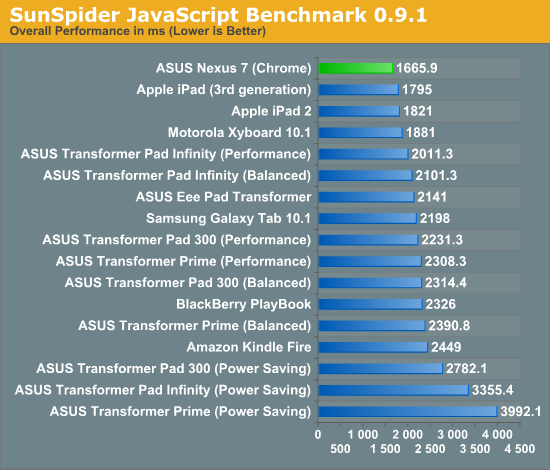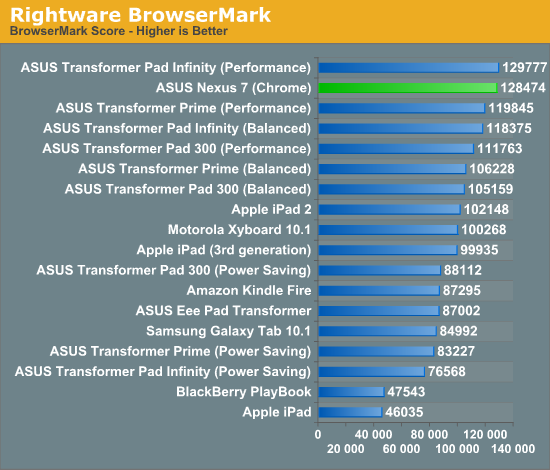The Google Nexus 7 Review
by Anand Lal Shimpi & Brian Klug on July 26, 2012 11:35 AM ESTThe SoC & Performance
While Amazon chose TI's OMAP 4 for the Kindle Fire, Google and ASUS picked arguably the second best SoC on the market today: NVIDIA's Tegra 3. Keep in mind that high-end ARM SoCs generally sell in the $14 - $25 range per chip, which a fabless semiconductor manufacturer has to split with a foundry. The result is a far cry from the margins NVIDIA is used to making on high-end discrete GPUs. I suspect a desire to make good use of all functional Tegra 3 parts that come back from the fab is the reason why we have so many variants of the Tegra 3.
To date we've seen three Tegra 3 SKUs used in tablets: T30L, T30 and T33. Factor in the smartphone SKUs (AP30, AP33) and it's already a pretty healthy collection for a single chip. The main differences between the 30L, 30 and 33 parts are voltages and clock speeds. I've shown this table in previous articles but I present it here again since T30L is what's in the Nexus 7:
| NVIDIA Tegra 3 | |||||||
| CPU Cores | Max CPU Clock (1 core active) | Max CPU Clock (multiple cores) | GPU Cores | Max GPU Clock | |||
| NVIDIA Tegra 3 (T33) | 4+1 | 1.7GHz | 1.6GHz | 12 | 520MHz | ||
| NVIDIA Tegra 3 (T30) | 4+1 | 1.4GHz | 1.3GHz | 12 | 520MHz | ||
| NVIDIA Tegra 3 (T30L) | 4+1 | 1.3GHz | 1.2GHz | 12 | 416MHz | ||
The loss in performance compared to T30/T33 is marginal at best, at least for most consumer use cases. Four Cortex A9s running at up to 1.3GHz is definitely quick enough for the types of applications you'll run on the Nexus 7. Things can always be faster, but like the Kindle Fire's OMAP 4, the Nexus 7's T30L is good enough for now. Give it another year and we'll see something even faster at this price point. That's the downside of buying anything in the tablet/smartphone space these days unfortunately.
| ASUS Android Tablet Memory Choices | ||||||
| TF Prime | TF Pad 300 | Nexus 7 | TF Pad Infinity | |||
| Memory Capacity | 1GB | 1GB | 1GB | 1GB | ||
| Memory Type | DDR2-1000 | DDR3L-1333 | DDR3L-1333 | DDR3-1600 | ||
| Memory Bandwidth | 4.0GB/s | 5.3GB/s | 5.3GB/s | 6.4GB/s | ||
ASUS selected 1GB of DDR3L-1333 memory for the Nexus 7. This gives it more memory bandwidth than any of the Transformer series of tablets, with the exception of the Transformer Pad Infinity. Since the Tegra 3 SoC only has a single channel memory interface, ASUS had to rely on higher frequency memory to deliver sufficient bandwidth.
Note that the browser performance tests below paint a very good picture for the Nexus 7's performance because Android 4.1 replaces the default web browser with Chrome, with a much faster javascript engine.













118 Comments
View All Comments
tuxRoller - Friday, July 27, 2012 - link
One more thing: the lag that happened when there was high io suggests that android isn't properly using the softirq for io that the preempt kernel provides.As for the cheap nand, I don't see why the oems couldn't use raw nand and then use a file system like nilfs or one of the others to let the kernel properly handle the io.
ssddaydream - Friday, July 27, 2012 - link
Interestingly, the Trinity kernel seems to improve IO throughput when used in conjunction with a certain script (TKT app runs the script when opened, I believe.)tipoo - Friday, July 27, 2012 - link
Yeah, I never got why it could be mostly smooth but going to a that blank search screen always lagged. Also similar to this if an app is writing to NAND it can take a while to get back to the home screen.TekDemon - Thursday, July 26, 2012 - link
To be fair the Kindle still has one other advantage as an e-Reader, you get to borrow a free book per month if you're a Prime member, in addition to the free video streaming support. So here it's really Amazon's ecosystem that's the Kindle's big feature-if you've bought into their ecosystem it'll give you quite a bit more content and they have a $39 per year student Prime (that you get after the expired Student trial) that does let you access videos/books.Of course if you're into the Amazon ecosystem I'd suspect that you're waiting on the Fire 2.
SantaAna12 - Thursday, July 26, 2012 - link
I think Gabe Newells comments regarding Apples controlling access is applicable to this device and Google. Google wants us on their cloud to sell us content.....its one of their business models. Amazon does the same.....but you can be smart and buy the CD. I think the more we talk about these issues the better......as knowledge is power. For me....this device doesn't work because of the lack of memory....and the known lack of sound quality.milli - Friday, July 27, 2012 - link
I feel you're ignoring the Playbook comparison a bit too much in this review. I've just bought a new Playbook 32GB for $175. Same 7" screen size (lower res though), OMAP4, bigger battery, better cam (front & back), ....Playbook OS is very usable since version 2.0. I use mine strictly professionally and at that, it's probably better than iOS en Android. Version 2.1 is around the corner and 3.0 around new years.
Maybe not the best option if you're an app addict but the amazing multitasking combined with what most call the best mobile browsing experience, made this a no brainer for me. The 'Print to Go' feature is very handy.
kenyee - Friday, July 27, 2012 - link
I have a Playbook too (earned it for porting an Android app).Playbook as muchhhhh better speakers.
Nexus 7 is what I grab for if I'm reading, etc. It's lighter than the Kindle and Nook so it's a lot more comfortable to hold for extended periods of time.
And no comparison to any 10" tablet...not sure what he reviewer is thinking...the 7" ones have a perfect use case for reading and playing games. The 10" ones might be better for web surfing for a little while until you get tired of holding it...
joshv - Friday, July 27, 2012 - link
One of my frustrations with the Fire (one of many) is the WiFi reconnect when you wake the device. It would frequently take 20-30 seconds, and that's a ton of time for a casual use device. On the other hand the iPad just seems to be always on the Internet. Pick it up, launch the browser, the Internet is on. I know that can't actually be the case, as it would decimate battery life, but the iPad somehow manages the WiFi connection almost perfectly.So, I am wondering how the Nexus 7 performs in this regard.
Impulses - Friday, July 27, 2012 - link
If it's anything like ASUS' other tablets (minus the Prime & it's signal strength issues) then it should be pretty seamless. I've rarely ever been held back while waiting for my original Transformer to connect, and I actually have it set to go into airplane mode when the screen is off, for maximum battery life... So it's doing a cold reconnect every time and it's usually good to go before I tap the browser icon.I'm pretty sure it reconnects faster than my Krait phone, tho the handover from 3G to Wifi is probably never given priority.
FWIW, the TF loses about half a percentage of battery life like that when sleeping. You can set it to always remain connected if you wanna receive live notifications or whatever but it'll obviously chew threw battery life much faster (probably twice as fast while idle, so you'd need to charge it every night or every other night at best).
kenyee - Friday, July 27, 2012 - link
It defaults to keeping wifi on even if the screen is off...and no problem w/ the batteries